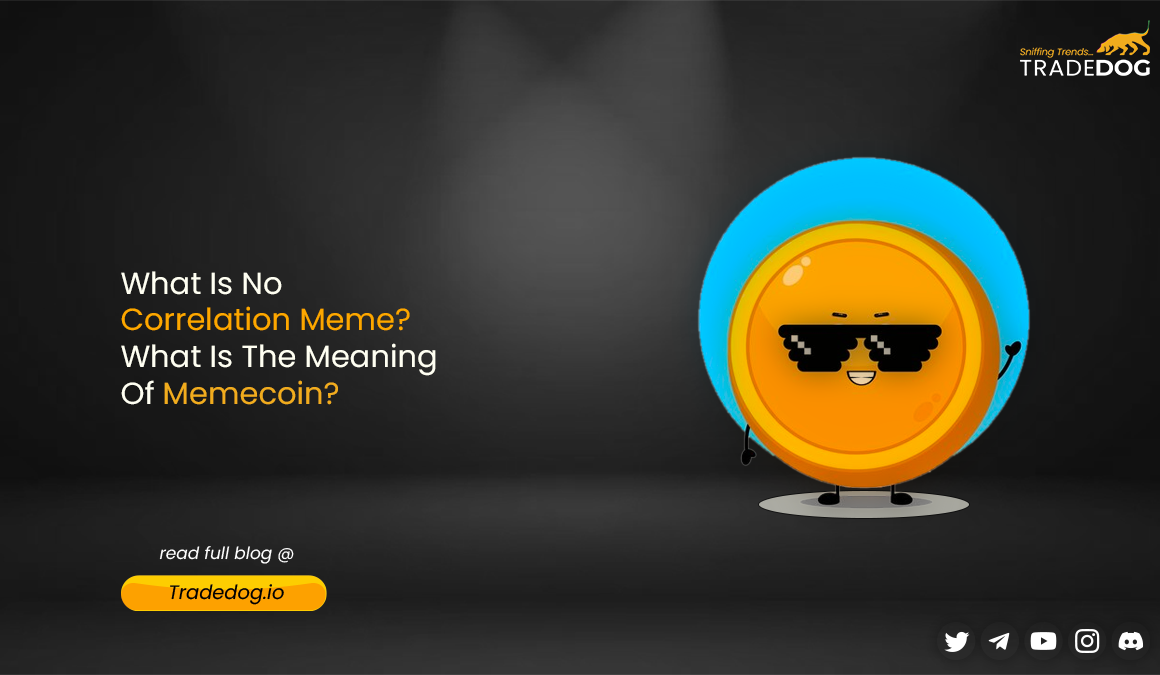Quick Links
In the ever-evolving landscape of cryptocurrencies, a new phenomenon has emerged: the world of memecoins. These digital assets, often born out of internet jokes or viral trends, have gained significant attention and traction in the crypto sphere. Among these memecoins is the curious ‘No Correlation Meme,’ a term that speaks to both the unpredictable nature and the unique appeal of these digital currencies.
What is ‘No Correlation Meme’?
The ‘No Correlation Meme’ refers to a meme-based cryptocurrency that, as the name suggests, lacks any substantial correlation to traditional financial assets or fundamental value. This term encapsulates a category of cryptocurrencies that are often created as a joke or satire, sometimes intentionally lacking utility or purpose beyond their memetic appeal.
The idea behind ‘No Correlation Meme’ coins is that their value is driven primarily by online trends, social media hype, and community engagement rather than traditional market factors. They often feature catchy names, playful branding, and sometimes even incorporate internet memes or cultural references into their design and marketing strategies.
Investing in these coins can be highly speculative and volatile due to their unpredictable nature. While some may view them as a lighthearted addition to the crypto space, others caution against investing in assets with no underlying value or purpose beyond their meme status.
Understanding Memecoins
The term ‘Memecoin’ broadly encompasses cryptocurrencies that gain popularity and value primarily due to their meme-based or cultural significance. These coins often leverage internet trends, jokes, or memes as their driving force, aiming to capitalize on the power of online communities and social media.
Unlike traditional cryptocurrencies such as Bitcoin or Ethereum, which often have underlying technology, use cases, or utility, memecoins may lack fundamental value. Instead, their value derives from the hype and attention generated by online communities, viral marketing campaigns, or celebrity endorsements.
However, within the realm of memecoins, not all projects are created equal. Some memecoins may evolve beyond their initial meme status, gaining utility, use cases, or a dedicated community that drives their long-term value. Others may fizzle out quickly once the online hype diminishes.
The Intersection of Memes and Markets
While seemingly frivolous, No Correlation memes and Memecoins highlight some interesting dynamics within the financial world:
- The power of hype and community: Memecoins like Dogecoin demonstrate how online communities can collectively influence the value of an asset, even if it has no tangible value.
- The search for meaning in randomness: No Correlation memes satirize the human tendency to find patterns in chaos, even when markets are inherently unpredictable.
- The democratization of finance: Memecoins offer a low-barrier entry point for individuals to participate in the crypto market, potentially bypassing traditional gatekeepers.
Trending Memecoins
Bonk Inu
Bonk Inu ($BONK) is a dog-themed memecoin on Solana’s blockchain which was launched on December 25, 2022. Claimed as the first Solana dog memecoin “for the people,” it has surged over 350% in the last 30 days, defying all market trends. Fueled by this fervor, the Solana Saga phone has significantly profited, as it featured 30 million BONK tokens initially valued at $10 during distribution. With the unforeseen surge, these tokens currently exceed the phone’s $599 price which has sparked a rush in the sales of the phone.
Pepe Coin
It draws its name and inspiration from Furie’s Pepe, a green humanoid cartoon frog originating from a 2005 comic book. Pepe’s meme soared in the 2010s and continues to hold significance. The Pepe Coin’s mascot pays tribute to the iconic first Pepe meme, now a legend in crypto. Its project announcement came solely via an April 4th tweet, marking its public debut. Trading commenced on April 17, 2023. It experienced a rally of ~ 7000% in May’23.
Shiba Inu
Shiba Inu (SHIB) originated in August 2020 under “Ryoshi,” and mirrors Dogecoin’s Shiba Inu mascot. It surged in 2021, hitting a peak Mcap of ~ $41 billion. It is widely revered as the “Dogecoin killer” by its zealous SHIBArmy. Given the recent updates, such as Shibarium, a layer-2 solution on Ethereum, which aims to streamline meme token communities, Shiba inu could pave the way for mass adoption of memecoins.
Dogecoin
Dogecoin could be considered as the coin that set a foundation for all the memecoins. It originated as a lighthearted joke in 2013, and quickly gained a following due to its Shiba Inu dog logo. It was initially conceived by Billy Markus and Jackson Palmer. Despite its humorous origins, Dogecoin soared to an all-time high market capitalization of over $90 billion in May 2021, garnering attention for its active community and social media-driven momentum. With the consistent backing of influential personalities like Elon Musk, it continues to be the leader in this space.
Conclusion
The emergence of ‘No Correlation Meme’ coins and the broader concept of memecoins highlight the evolving and often unpredictable nature of the cryptocurrency market. While these coins may serve as a form of entertainment or a reflection of internet culture, investing in them requires careful consideration and an understanding of their inherent risks.
As with any investment, conducting thorough research, understanding the project’s fundamentals (if any), and being aware of the speculative nature of memecoins is crucial. The meme-driven nature of these assets can result in extreme volatility and rapid price fluctuations, making them a high-risk, high-reward investment for those willing to participate in this niche corner of the crypto world.








